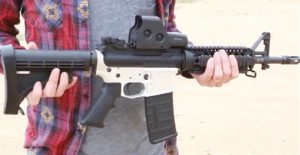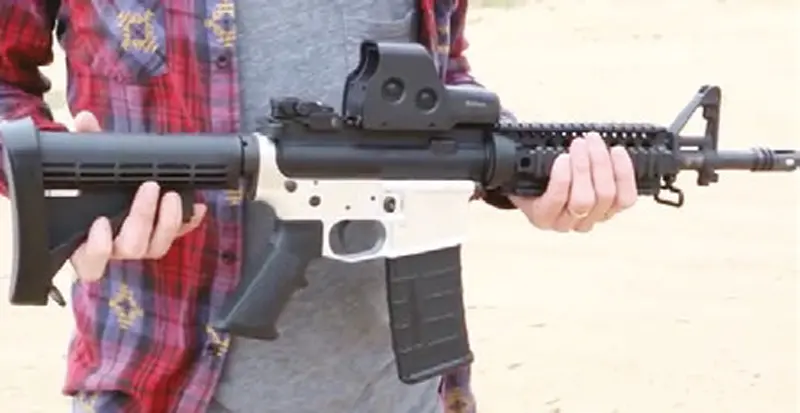Since 2012, Cody Wilson, at that time a law student at the University of Texas, has been the face of, and driving force behind, the movement to bring home manufacture of firearms to the masses.
His company, Defense Distributed, released plans in 2013 for the “Liberator” pistol—a gun that would be made entirely of plastic except for a nail to act as the firing pin and a small, non-functional piece of steel included in order to comply with the federal law against firearms that have no metallic components and could thus theoretically be “undetectable” by conventional means. The plastic components would be made on 3-D printers, which were just becoming available at prices practical for individual consumers.
The Liberator name was presumably chosen with some care. The original Liberators were cheap stamped-metal single-shot .45s with crude sights that in World War II were air-dropped by the Allies for the benefit of Resistance fighters behind German lines.

The idea was that the fighter, pretending to be a frightened conquered subject of the Third Reich, could get within a few feet of an unsuspecting German soldier, shoot him with the Liberator, and then, er … liberate that soldier’s far more effective arms.
Cody Wilson’s Liberator could be considered an even less formidable arm than the original. Chambered not for the respected .45 ACP caliber but for the less powerful .380 ACP, it is also single shot, capable of being “aimed” only in the most general sense, and (unlike the original) not likely to be fired and reloaded many times before blowing up.
Wilson was not proposing that anyone use his Liberator to kill any law enforcement or military personnel in order to take their weapons. But the name is still appropriate, because the mere existence of guns that anyone can make at home, without any government official’s permission, or even knowledge, “liberates” the people from the notion that the government can control their ability to arm themselves.
Wilson did not sell the computer files that a user’s 3-D printer would use to make these guns. His intention was to provide those files for free to anyone who had Internet access. The Obama regime was not slow to recognize this threat to its ability to throttle down, or even block completely, the people’s access to liberty-preserving firepower.
In the face of that threat, the government forced Defense Distributed to remove the file from their Internet server, under a tortured interpretation of a law that forbids “exportation” of weapons without State Department approval.
Posting a file on a domestic Internet server seems a long way from “exporting” anything, and electronic files are not exactly “weapons,” but the government has not yet relented. Wilson, with the help of the Second Amendment Foundation, has turned to the courts to get the ruling lifted.
In the end, the ham-handed attempt to control not just guns but also information about guns was an abject failure, as by the time Defense Distributed was forced to remove the files, they could be found on many foreign servers, over which the U.S. government has no control. Within days, the files had been downloaded hundreds of thousands of times.
Since the release of (and the government’s failed attempt to recapture) the Liberator plans, Wilson and Defense Distributed have not been idle, and have indeed moved on to projects that are not just conceptual or symbolic threats to gun control but actually make practical, effective firepower more accessible than ever before.
Anyone with an Internet connection and a 3-D printer can now print his or her own 30-round “high-capacity” magazines for AR or AK pattern rifles. And in jurisdictions that ban such magazines, there is very little to be done to prevent it.
Perhaps even more significantly, one can “print” an entire lower receiver for an AR-15 pattern rifle. This is significant because, unlike the upper receiver, a lower receiver is not subject to most of the forces generated with the firing of a 5.56x45mm NATO or .223 Remington cartridge, and thus can be counted on to stand up to the firing of hundreds, maybe even thousands, of rounds.
Additionally, in the eyes of the law, the lower receiver is the gun. It’s the only part regulated under federal law, the only part required to be marked with a serial number, the only part for which a background check is required for its purchase. In other words, if you can make that part, you can legally buy everything else needed to build a gun—without the government’s permission or even knowledge.
After that, Defense Distributed moved beyond 3-D printing, which, despite its vast and rapidly improving potential, is still probably not (yet) the best way to outfit oneself with effective firepower. The next project was the “Ghost Gunner,” a consumer- grade CNC (Computer Numerically Controlled) milling machine that, instead of printing lower receivers out of plastic, mills them from aluminum.
Again, the name was no accident. Rabidly anti-gun California state senator Kevin de León invented the term “ghost gun,” both for guns that are produced at home without government knowledge (scary, scary!) and for guns that metal detectors can’t find (or can’t if someone ever invents all-plastic ammunition).
Defense Distributed cannot build the $1,500 Ghost Gunners fast enough to keep up with demand.
Now Wilson has upped the ante yet again, promising (or “threatening,” as the forcible citizen disarmament lobby undoubtedly sees it) to release plans for a homemade machine gun to be made from about $150 worth of components. Of course, this has gun-ban fanatics in a lather, and not just those in the U.S.
The British tabloid the Daily Mirror, calling Wilson a “gun fanatic,” quoted British counterterrorism expert Hamish de Bretton Gordon claiming that Wilson “is making terrorists’ jobs so much easier.” He goes on to express his hope that “the authorities in the U.S. are going to deal with this individual. It’s absolutely crazy.” What he means by “deal with” is not clear, but now he wants governments to monitor anyone who owns a 3-D printer.
Also in the U.K., Shadow Police Minister Jack Dromney worries a “plastic machine gun” would put “the traveling public at risk of terrorist attack.”
Terrorists in Europe have not experienced much difficulty obtaining fully automatic firearms without Wilson’s help, but that is apparently not the point. What much more plausibly is the point is that those who wish for the government to have the power to disarm the citizenry are now seeing that sick fantasy fall apart. Be afraid, gun-ban zealots. Be very afraid.



